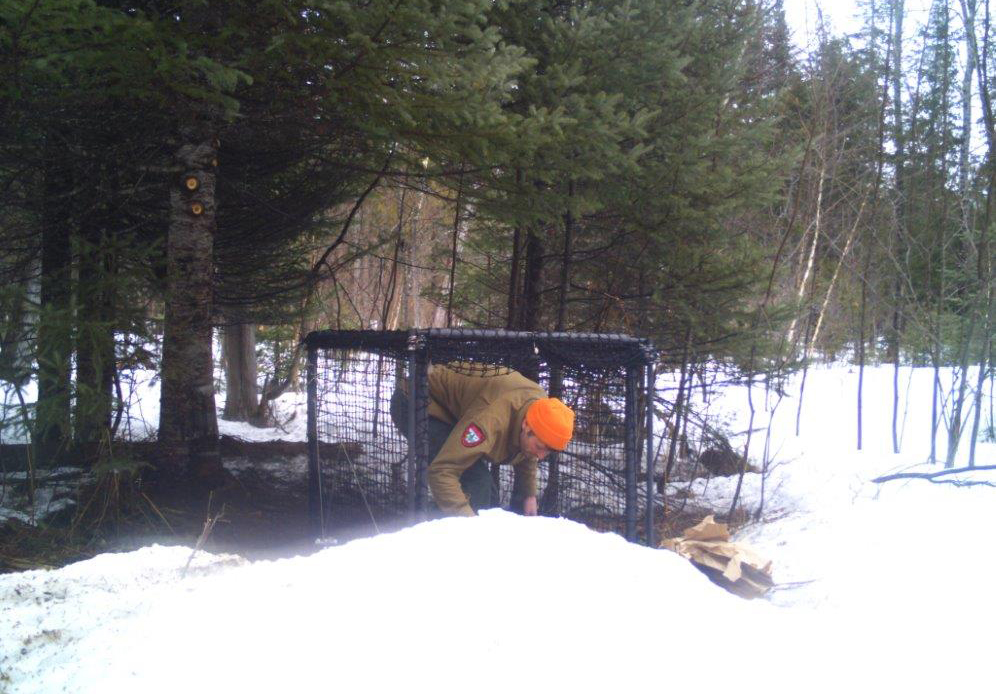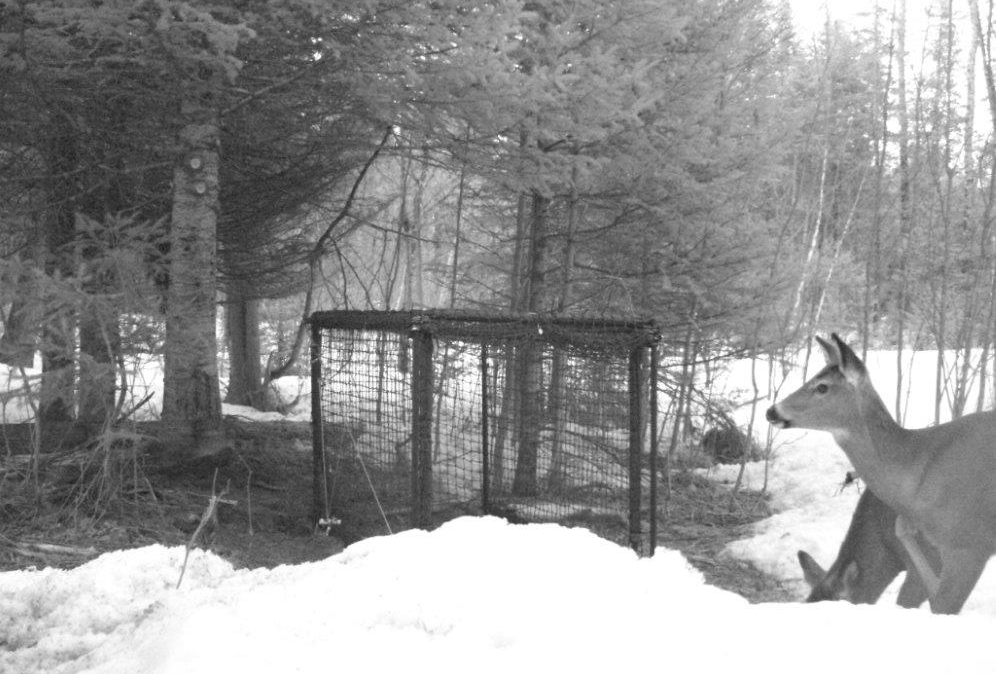March 23, 2017 at 11:39 am
By Regional Wildlife Biologist Keel Kemper
Regional wildlife biologists are frequently involved with a variety of tasks to support various wildlife work programs statewide, so imagine our excitement when we were asked to help live trap some deer! Wow, what a job assignment! Are you kidding me, I get to do that? In reality, it is a task that is easier said than done!
[caption id="attachment_2204" align="alignright" width="364"] Kendall Marden prepares the live trap[/caption]
Maine Department of Inland Fisheries and Wildlife, Region B wildlife biologists have been assisting Kyle Ravana, the state's deer biologist, in a long term deer mortality / survival study. This study has been going on for three years and is designed to give us valuable information on whitetail deer that will later help inform wildlife policy.
We manage all wildlife species in Maine at the wildlife management district level (WMD) and this particular effort is occurring in WMD 17, a transition district between the farm lands of central Maine and the spruce fir forest of northern Maine. We are trapping in the town of Cannan, on private property with landowner permission. We have monitored winter severity and the impacts on deer at this deer wintering area for more than three decades. We have visited this location once a week, every week, all winter long for more than thirty years. Since this area is a known deer wintering area, it is a natural choice to try to live trap a few deer during the winter.
Kendall Marden prepares the live trap[/caption]
Maine Department of Inland Fisheries and Wildlife, Region B wildlife biologists have been assisting Kyle Ravana, the state's deer biologist, in a long term deer mortality / survival study. This study has been going on for three years and is designed to give us valuable information on whitetail deer that will later help inform wildlife policy.
We manage all wildlife species in Maine at the wildlife management district level (WMD) and this particular effort is occurring in WMD 17, a transition district between the farm lands of central Maine and the spruce fir forest of northern Maine. We are trapping in the town of Cannan, on private property with landowner permission. We have monitored winter severity and the impacts on deer at this deer wintering area for more than three decades. We have visited this location once a week, every week, all winter long for more than thirty years. Since this area is a known deer wintering area, it is a natural choice to try to live trap a few deer during the winter.
 At the site, we are using a box type live trap with an aluminum frame and nylon netting, with a drop down door at the front of the trap. The deer's nose is what springs the trap as they consume the bait. We bait it frequently and only occasionally set the trap to increase success. For the study, it is important that we keep a certain number of deer "on the air" (collared) at all times as mortalities must be replaced. Each successfully collared fawn is a step forward as each individual deer gives us unique and valuable information. The radio collars are designed to be light but rugged. Rubber surgical bands allow for the growth in the neck diameter of the fawn as it ages, ensuring a proper fit and no harm to the deer. The radio collar sends out a mortality signal if it detects that the deer has died. We are then able to locate the signal, and subsequently the deer, to determine the cause of death.
We are fortunate to have some first class people working on behalf of the wildlife resources of the state of Maine. Regional Wildlife Biologist Kendall Marden is invaluable to this effort as he brings a skill set that is hard to duplicate. Kyle Ravana, our deer biologist, is leading a great effort that will continue to provide important information about deer mortaility and survival. Additionally, John Pratte and Zach Pulsifer contribute consistently in support of these and other wildlife work programs.
Below is a short video showing the process of tagging and collaring a young deer that was recently live trapped and quickly released.
[embed]https://youtu.be/qZdniFMDxcA[/embed]
At the site, we are using a box type live trap with an aluminum frame and nylon netting, with a drop down door at the front of the trap. The deer's nose is what springs the trap as they consume the bait. We bait it frequently and only occasionally set the trap to increase success. For the study, it is important that we keep a certain number of deer "on the air" (collared) at all times as mortalities must be replaced. Each successfully collared fawn is a step forward as each individual deer gives us unique and valuable information. The radio collars are designed to be light but rugged. Rubber surgical bands allow for the growth in the neck diameter of the fawn as it ages, ensuring a proper fit and no harm to the deer. The radio collar sends out a mortality signal if it detects that the deer has died. We are then able to locate the signal, and subsequently the deer, to determine the cause of death.
We are fortunate to have some first class people working on behalf of the wildlife resources of the state of Maine. Regional Wildlife Biologist Kendall Marden is invaluable to this effort as he brings a skill set that is hard to duplicate. Kyle Ravana, our deer biologist, is leading a great effort that will continue to provide important information about deer mortaility and survival. Additionally, John Pratte and Zach Pulsifer contribute consistently in support of these and other wildlife work programs.
Below is a short video showing the process of tagging and collaring a young deer that was recently live trapped and quickly released.
[embed]https://youtu.be/qZdniFMDxcA[/embed]
 Kendall Marden prepares the live trap[/caption]
Maine Department of Inland Fisheries and Wildlife, Region B wildlife biologists have been assisting Kyle Ravana, the state's deer biologist, in a long term deer mortality / survival study. This study has been going on for three years and is designed to give us valuable information on whitetail deer that will later help inform wildlife policy.
We manage all wildlife species in Maine at the wildlife management district level (WMD) and this particular effort is occurring in WMD 17, a transition district between the farm lands of central Maine and the spruce fir forest of northern Maine. We are trapping in the town of Cannan, on private property with landowner permission. We have monitored winter severity and the impacts on deer at this deer wintering area for more than three decades. We have visited this location once a week, every week, all winter long for more than thirty years. Since this area is a known deer wintering area, it is a natural choice to try to live trap a few deer during the winter.
Kendall Marden prepares the live trap[/caption]
Maine Department of Inland Fisheries and Wildlife, Region B wildlife biologists have been assisting Kyle Ravana, the state's deer biologist, in a long term deer mortality / survival study. This study has been going on for three years and is designed to give us valuable information on whitetail deer that will later help inform wildlife policy.
We manage all wildlife species in Maine at the wildlife management district level (WMD) and this particular effort is occurring in WMD 17, a transition district between the farm lands of central Maine and the spruce fir forest of northern Maine. We are trapping in the town of Cannan, on private property with landowner permission. We have monitored winter severity and the impacts on deer at this deer wintering area for more than three decades. We have visited this location once a week, every week, all winter long for more than thirty years. Since this area is a known deer wintering area, it is a natural choice to try to live trap a few deer during the winter.
 At the site, we are using a box type live trap with an aluminum frame and nylon netting, with a drop down door at the front of the trap. The deer's nose is what springs the trap as they consume the bait. We bait it frequently and only occasionally set the trap to increase success. For the study, it is important that we keep a certain number of deer "on the air" (collared) at all times as mortalities must be replaced. Each successfully collared fawn is a step forward as each individual deer gives us unique and valuable information. The radio collars are designed to be light but rugged. Rubber surgical bands allow for the growth in the neck diameter of the fawn as it ages, ensuring a proper fit and no harm to the deer. The radio collar sends out a mortality signal if it detects that the deer has died. We are then able to locate the signal, and subsequently the deer, to determine the cause of death.
We are fortunate to have some first class people working on behalf of the wildlife resources of the state of Maine. Regional Wildlife Biologist Kendall Marden is invaluable to this effort as he brings a skill set that is hard to duplicate. Kyle Ravana, our deer biologist, is leading a great effort that will continue to provide important information about deer mortaility and survival. Additionally, John Pratte and Zach Pulsifer contribute consistently in support of these and other wildlife work programs.
Below is a short video showing the process of tagging and collaring a young deer that was recently live trapped and quickly released.
[embed]https://youtu.be/qZdniFMDxcA[/embed]
At the site, we are using a box type live trap with an aluminum frame and nylon netting, with a drop down door at the front of the trap. The deer's nose is what springs the trap as they consume the bait. We bait it frequently and only occasionally set the trap to increase success. For the study, it is important that we keep a certain number of deer "on the air" (collared) at all times as mortalities must be replaced. Each successfully collared fawn is a step forward as each individual deer gives us unique and valuable information. The radio collars are designed to be light but rugged. Rubber surgical bands allow for the growth in the neck diameter of the fawn as it ages, ensuring a proper fit and no harm to the deer. The radio collar sends out a mortality signal if it detects that the deer has died. We are then able to locate the signal, and subsequently the deer, to determine the cause of death.
We are fortunate to have some first class people working on behalf of the wildlife resources of the state of Maine. Regional Wildlife Biologist Kendall Marden is invaluable to this effort as he brings a skill set that is hard to duplicate. Kyle Ravana, our deer biologist, is leading a great effort that will continue to provide important information about deer mortaility and survival. Additionally, John Pratte and Zach Pulsifer contribute consistently in support of these and other wildlife work programs.
Below is a short video showing the process of tagging and collaring a young deer that was recently live trapped and quickly released.
[embed]https://youtu.be/qZdniFMDxcA[/embed]
Categories